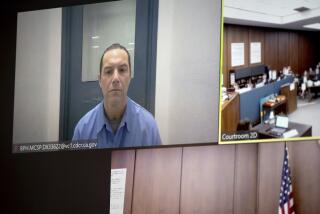Judge Allows Testimony About Bloodhound
- Share via
SANTA ANA — A judge ruled Wednesday that prosecutors will be allowed to tell jurors that an accused killer was tracked by a bloodhound, even though the scent came from clothing stored in a freezer for months and extracted using a controversial new method.
The ruling buttresses the case against Earl Rhoney, 20, who was arrested in the 1994 slaying of an Irvine woman after authorities tracked him using a bloodhound that has worked in 200 investigations.
The defense challenged the tracking method, which involved transferring the scent from the victim’s sweatshirt, using a high-tech vacuum, onto a cotton pad. The bloodhound then sniffed the pad. Defense lawyers maintained that the method was not yet proved reliable and might have mistakenly led the dog to Rhoney, who had just been released from Juvenile Hall.
But Orange County Superior Court Judge Anthony Rackauckas Jr. said subsequent tests of the vacuum method indicated that scents, which are an accumulation of dead skin cells, can be successfully transferred from an article of clothing to a pad, then used for tracking. He said jurors could decide the “critical issue” of whether the assailant’s scent was on the cotton pad given to the bloodhound, named Duchess.
Police said the victim, Patricia Pratt, surprised Rhoney, then 17, while he was burglarizing her house in the exclusive Turtle Rock community on Jan. 20, 1994. Paul Pratt found his wife’s body, strangled and bludgeoned, when he returned home from a meeting that night.
Detectives began to suspect Rhoney soon after when he was linked to another burglary in the same community, near where he lived with his grandfather. Nine months later, investigators used the vacuum device to extract the scent from the victim’s sweatshirt, which had been kept in a freezer, and transferred onto a sterile gauze pad.
Two days later, the dog’s handler, Larry Harris, and an Irvine detective took Duchess to Juvenile Hall, where Rhoney was being released after serving time for burglary and weapons charges. The dog tracked him to a nearby shopping center, where Rhoney stopped to make a telephone call.
The ruling was seen as a key victory for prosecutors, who said in court papers that the method “combines the best aspects of dog tracking and lineups.” Prosecutors said they have other evidence against Rhoney, although the defense contends the case is largely circumstantial and does not prove guilt.
“The jury will be the final one to determine the reliability” of the method in Rhoney’s case, said Alan Crivaro, a deputy public defender who sought to keep out the tracking evidence.
The trial is scheduled to begin Sept. 3.
More to Read
Sign up for Essential California
The most important California stories and recommendations in your inbox every morning.
You may occasionally receive promotional content from the Los Angeles Times.













